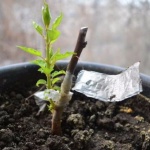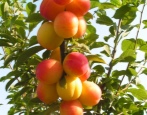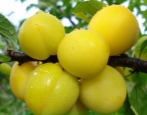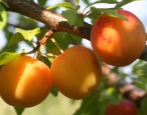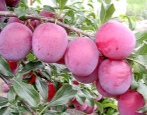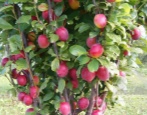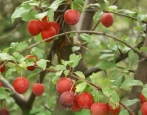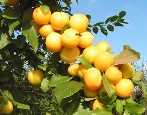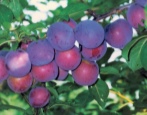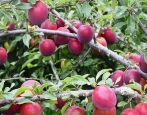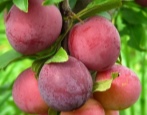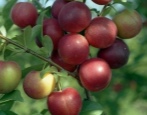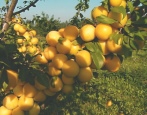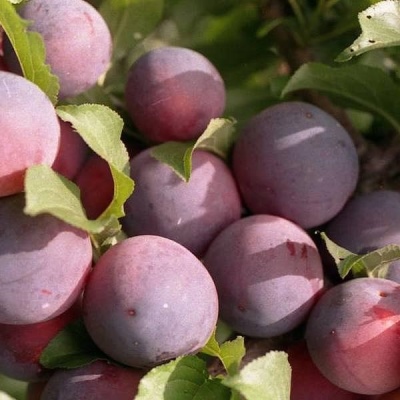
- Year of approval: 1995
- Growth type: undersized
- Ripening period: early
- Self-fertility: self-infertile
- Fruit size: large
- Yield: high
- Appointment: universal
- Fruit weight, g: 40
- Fruit shape: broadly ovate
- Fruit color: yellowish green with a red continuous blush, when ripe completely burgundy, waxy bloom is poorly expressed
Cherry plum is not so popular for growing on a personal plot. This was the case until recently. With the advent of hybrid varieties, the popularity of this crop has increased significantly. The tree is considered universal, the plant is able to adapt to any climatic conditions, to give stable yields of aromatic and tasty fruits. Cherry plum of the Shater variety is ideal in this regard.
Description of the variety
The culture is weak. The maximum height of an adult tree is 2.5 meters. The crown is round, slightly flattened and rather dense. Shoots are long, dark gray in color. Cherry plum leaves are oval with a strongly pointed tip. The leaves are wrinkled, with a rich green hue.
Fruit characteristics
Large-fruited hybrid. The mass of one cherry plum can reach 40 g. Their shape is broadly ovate. The color of ripe fruits is rich burgundy, with a deep ventral seam at the base. The wax coating is poorly expressed.
Taste qualities
Cherry plum Tent has a pleasant sweet and sour taste with a mild aroma. The pulp is yellow, the consistency is dense, moderately juicy, granular-fibrous and sugary. The stone is medium, difficult to separate from the pulp. The fruits have a universal purpose in cooking. They make delicious compotes, preserves, jams, juices and more.
Ripening and fruiting
Fruiting occurs in the 3rd year of planting. Refers to early ripening varieties. The tree blooms in mid-April. Ripe fruits can be enjoyed in early July.
Yield
High-yielding variety. On average, 35 kg of fruit can be harvested from one tree.
Self-fertility and the need for pollinators
Culture is self-fertile. Therefore, next to the tree, it is necessary to plant a plant with a similar fruiting period, which can serve as a pollinator to obtain a good harvest.
Growing and caring
The culture is drought and frost resistant. Cherry plum Tent calmly endures a short drought. If the weather is very hot, the tree will need frequent watering, especially during flowering and fruit formation. The variety is able to withstand frosts down to -25 degrees, and even in the case of freezing of the shoots, the branches recover rather quickly.
Experienced gardeners advise planting the hybrid in the spring, before the sap begins to flow. In the southern regions, planting work begins at the end of March, in the central and middle lane in mid-April. Cherry plum is not planted in autumn, as it will not have time to take root and is more likely to die.
A sunny place protected from drafts is chosen for planting. Cherry plum prefers to grow on fertile, well-drained soils. However, it also bears fruit well on poor soils.
Before planting a tree on the site, you must take into account possible neighbors. No other stone fruit crops are planted near the cherry plum. But it gets along well with low bushes.
The best seedlings for planting are 1-2 year old specimens. Twigs and roots should not show signs of disease and damage. A day before planting, they are soaked in a root-forming solution or in ordinary water to start metabolic processes.
The landing pit is prepared several weeks before disembarkation. The hole is dug 60x60 cm in size.A drainage layer is laid at the bottom. A soil mixture consisting of garden soil, peat, sand, compost is prepared, and mineral fertilizers (phosphorus, potassium and nitrogen) are added. Mix thoroughly and divide in two.
In the center of the hole, a mound is made and a seedling is placed on it, carefully straightening the roots. Water abundantly. As the water is absorbed, the hole is covered with the remaining soil mixture. Ramp gently and irrigate again abundantly. Finally, mulch is laid around the trunk.
For the next few years, there is no need to make additional fertilizing. Enough of those added at disembarkation. Starting from the 3rd year of development, the trees are fed several times a year. Organics will be needed in early spring. With the onset of flowering and the formation of fruits, cherry plum is needed phosphorus-potassium fertilizers.
The Tent variety does not require molding pruning. It will be enough for cherry plum to carry out sanitary pruning in spring and autumn. Remove dry, damaged, with signs of disease, broken twigs. To enhance the growth of lateral shoots, the tops are pinched.
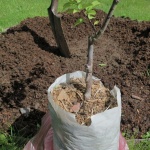
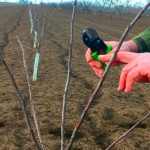
Disease and pest resistance
Cherry plum Tent is characterized by strong immunity to most of the infectious diseases inherent in stone fruit crops. The tree is also little susceptible to pests. For prophylaxis, in the spring, the trunk and branches are sprayed with a solution of copper sulfate.

